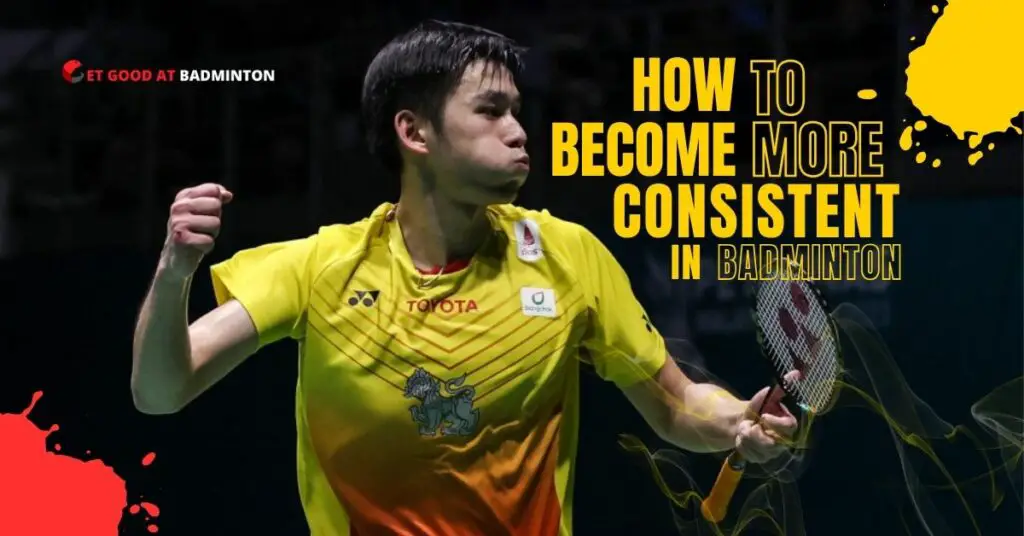As tournament season is underway here in Canada and players begin playing their first few tournaments, people frequently ask me how to become more consistent in badminton and make fewer mistakes. This is a great question to be asking, as it’s not enough to be able to play well. You need to play well all the time. In this article, I will give tips and strategies to help you become more consistent in badminton.
Training Philosophy and Mindset
One of the things that helped my brother and I improve our consistency considerably was adjusting our mindset regarding training. You see, we used to do a lot of consistency drills, but we saw more improvement in our last two months than the six months we spent practicing consistency on our own.
This is because we found a new coach with much higher standards. If we made more than a certain number of mistakes during drills, we would have to do extra fitness as punishment. Additionally, these numbers originally appeared extremely difficult.
For example, someone at my skill level was only allowed two mistakes in five minutes playing one against two, with everybody allowed to play any shot. We also had drills where we had to hit 20 shots or more in a row and do it multiple times within a specific time limit.
At the start, I thought these expectations were extremely unrealistic. But as we continued pushing towards these numbers, we quickly improved our consistency. These expectations make a lot of sense, too. If you were to play against an opponent close to your skill level, two points are all the difference between a win or a loss. Random, unforced errors often determine the winner and loser.
Additionally, our new coach also put heavy emphasis on our mental state and learning how to play consistently. First, we have to understand what playing consistently looks like. Consistency is not just about not making mistakes. It’s about playing good quality shots at your full speed with no mistakes.
To do this, one must focus. The person who can focus the longest and consistently refocus after losing focus will be the one who wins. Pay attention to your mental state when you’re playing and training. You can’t let your mind wander off into the middle of nowhere.
Stability, Preparation, and Short, Quick Swings
What our new coach specialized in, however, was teaching us new techniques and pointing out small things that we could change in our game to be even better. There are three things you should do to be more consistent in badminton.
First, you need to be more stable. Adjust your rhythm if you can’t control the shuttle while moving at super-fast speeds. Ideally, your first few steps toward the shuttle should be fast, but you should generally slow down the last step to have more control over your shot. You also want to engage your core and keep your upper body at the same level as much as possible to give you more control.
The second thing that will help you become more consistent is to ensure your ready position is always the same and that you’re only moving your racket to play a shot or into a ready position. If you move your racket around randomly, you’ll find yourself mishitting more due to the few milliseconds it takes to get your racket from an unknown position into your ready position.
Focusing on short, quick swings is the third technique that will drastically improve your consistency. A lot of people make the mistake of swinging super big. The problem with big swings is that they’re inconsistent. If you’re just a little too tired, or the shuttle moves a little bit due to drift or whatever, a bigger swing increases your chance of making an error.
Additionally, people commonly make the mistake of swinging slower when trying to make fewer mistakes. The thought process is that they should slow down to make sure every part of their swing is correct. Unfortunately, this has the opposite effect. The slower and more mechanical your swing becomes, the more likely you are to make a mistake.
I used to make this mistake a lot. I would mess up a drop shot, slow down my swing, and ultimately play even worse drop shots. Instead, it would be best if you still tried to keep your speed up. A good swing should be fast and fluid.
Drills To Practice
Now that you know what mindset you need to have and understand some of the technical aspects of playing more consistently, you must practice these things.
The best way to practice consistency is through various single-shuttle drills where you play one continuous rally with one shuttle. For example, if you need to practice your drop shots, you can start by just playing drop shots from one corner for two-minute durations.
You can adjust your drills by changing what shots each player can play and the duration. Instead of only playing drops from one corner, you can add in the other corners and play net shots. At the start, you might do a pattern where you drop, net, and repeat, but eventually, you can make it random to make it more difficult.
At some point, you want to be able to play one-on-one or one-on-two full court, where all players can play any shot. One of my coach’s favorite drills is where you have two workers and two feeders and have the workers play one-on-two against the feeders. For every two mistakes or 20 consecutive shots the worker plays, the worker has to switch with the other worker. The goal is for each worker to play five rounds of 20 straight shots within 15 minutes.
Playing Shots Where You Make Less Mistakes
“Thanks for all this, Kevin, but I’m pretty consistent in practice. It’s during tournaments that I start making more mistakes.”
This is something widespread among all athletes. We might be able to do something very well during practice, but it becomes difficult to perform under pressure.
Much of this concerns your mental state and ability to control your emotions. I’ve written a few articles on this topic already that you can check out below:
- 4 Tips To Help You Control Anxiety And Play Better Under Pressure In Badminton
- 5 Must-Follow Mindset Principles To Achieve Maximum Success In Badminton Tournaments
Apart from controlling your mental state, there are also a few other things you can do to play more consistently in tournaments. One of these things is to play shots where you make fewer mistakes.
For example, play fast drops and blocks towards the middle. These neutral shots are easy to execute and challenging for opponents to punish. In general, try to play a more box style where you’re not reliant on hitting your shots super tight to the net or lines. Make things easy for yourself, and as you start getting a feel for the shuttle and court conditions, you can start playing more risky shots like spin nets and deceptions. And if you start making mistakes, revert to simple shots and box game.
Additionally, many players make a mistake by focusing on hitting the lines. Yes, we would all love to nail the lines, but different shuttle and playing conditions make it challenging to do it every time. And even if you do nail the line, there’s always a chance that your opponent or line judge makes the wrong call.
To avoid these problems, aim at the orange lines I drew in the picture of a badminton court below:

Aiming for the orange lines gives you more room for error. If you hit the orange line, that’s a great shot. If you mess up a little and hit outside the orange line, there’s still a high chance it’s in the court. And if you hit inside, just keep the rally going.
How To Become More Consistent In Badminton
I hope this article helped you figure out how to become more consistent in badminton and make fewer mistakes. To recap, consistency starts with your mindset. Don’t tolerate easy mistakes, and remember that consistency is also about playing high-quality shots.
Once you figure out the mindset part, remember that playing consistently comes from being stable on the court, keeping your preparation the same, and using short, quick swings. To practice this, do single shuttle drills against other players, where you must continuously keep the rally going without any mistakes.
Also, practice your neutral shots and aiming inside the court rather than at the line. During tournaments where playing conditions can drastically differ, you need to be able to play a style where you’re less likely to make mistakes.
Have any questions? I’ll be happy to help you out in the comment section below!

